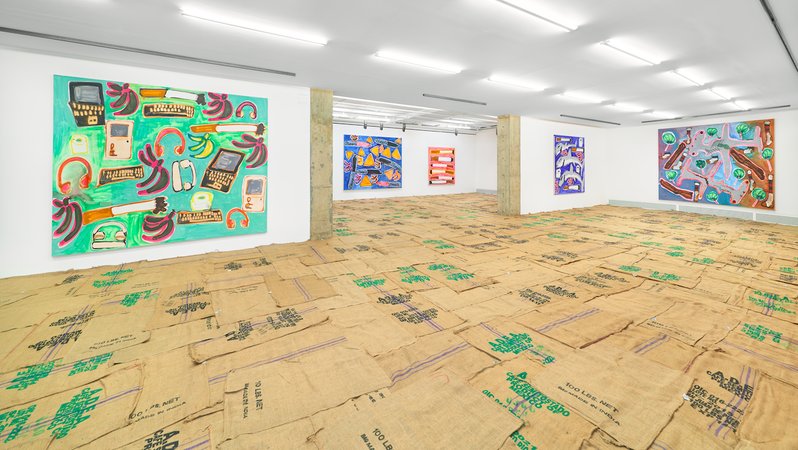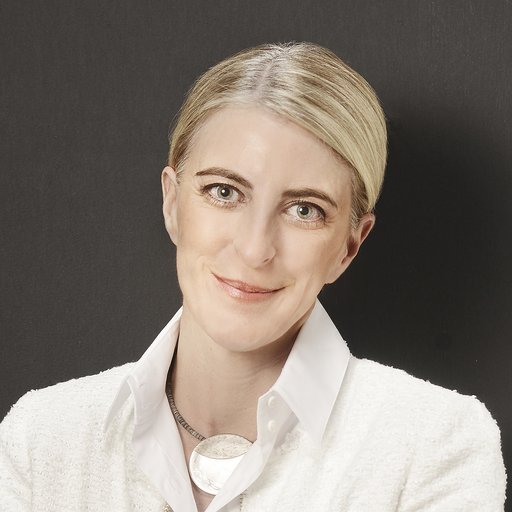After bursting onto the contemporary art scene with her thickly-painted portraits of magazine models, Katherine Bernhardt turned her attention to making "pattern paintings": large-scale works that present banal store-bought products such as toilet paper, Doritos chips, and cigarettes in jazzy, semi-abstract combinations that bring to mind doodles or graffiti. This fascination with repetition and juxtaposition extends to her business venture Magic Flying Carpets , which focuses on the import and sale of traditional Berber rugs from Morocco.
Her new show at Venus Over Manhattan (on view September 9 - October 24) is inspired by a visit to Puerto Rico at the invitation of Alberto de la Cruz (the son of the Miami-based contemporary art collectors Carlos and Rosa de la Cruz ) to make commissioned paintings for the Coca Cola bottling factory. In these works Bernhardt, a longtime lover of the Caribbean, borrows from the island’s colors and forms, adding tropical flourishes like sharks and palm trees to her repertoire. Artspace’s Dylan Kerr talked with the Brooklyn-based painter about the formal beauty of the deli, her aversion to intellectualizing her work, and why San Juan is primed to become the next art-world capital.
Your new show is called “Pablo and Efrain,” after the artists behind the Puerto Rican art group Poncili Creacion . Why name the show after these two?
They’re kind of my muses. I met them while I was down there on a residency this winter. We share the same gallery in Puerto Rico, Roberto Paradise. They represent Puerto Rico for me—they’re hilarious, they’re smart, they’re colorful, they’re totally creative, and they’re full of energy. They’re twins, too [laughs].
These paintings were inspired in part by your recent stay in Puerto Rico. What can you tell me about that time?
I’ve been going down there for the past 10 years—I love Puerto Rico. I was down there this winter, and Alberto de la Cruz commissioned me to come make some paintings for the Coca Cola bottling factory. I had a studio down there, I made a ton of work, and he bought some. The works you’re seeing in this show were all made in New York, though. They’re meant to be super-colorful, like the island—they have toucans, parrots, fruit, sharks, water, coffee, papayas, stuff like that.

What was it like painting for the Coca Cola factory? It seems like that would be an interesting and very specific commission.
It was kind of perfect, because Alberto does all the canning for the whole Caribbean. They make all the drinks—Coco Rico, Fanta, Diet Coke, all those cans and bottles that I’m already interested in and have worked with in the past. He thought it would be a good match.
In terms of your process, how do you settle on the different images or motifs that you’re going to work with in these paintings?
I’ll pick a couple of things I want to make a painting of, like hammerheads, Malta India , and tostones. The selection is totally random. After I’ve chosen the components, I’ll make a giant drawing on the canvas with spray paint. I actually make the painting on the floor, so it’s more fluid and watery. I add tons of water into the paint to make it more liquid.
In a review of your work in the Los Angeles Times , Christopher Knight wrote that your paintings show “the world awash with the heaven-and-hell of consumer products.” Are you thinking about these subjects as consumer products specifically, or do they function more like simple images?
[Laughs.] I guess a little of both. Someone also said that the paintings are also about environmental hazards, and I’m into that idea too. Sharks in water with toilet paper—OK, yeah, the oceans are trashed, so maybe they’re about environmentalism. I like that.

Are these things that you’re thinking about while you’re planning your paintings? What do you make of these associations with consumerism, environmentalism, or whatever?
It just kind of happens. I guess it’s more subconscious than anything. I’m thinking more about daily life, about products and things that we use. I’m thinking about stuff at the deli, things like that.
Why are you attracted to these quotidian items?
They’re just good colors and shapes. Look at a sock: it’s got really good colors, white with red and blue stripes. Toilet paper is a squarish oval. A cigarette is a line. A dorsal fin is a triangle, and so is a Dorito.
My favorite part about your paintings are their almost aggressively amateurish quality—they’re really rough around the edges, in a great way. You clearly know a thing or two about “proper” painting technique, so I’m wondering where this impulse towards deskilling comes from.
I don’t know [laughs]. I guess that’s just how I paint. My older paintings have thicker paint and a more direct brushstroke, but these are more like giant watercolors—they’re fluid. I’m not using watercolor paint, although I do make tons of watercolors on the side.
Do you see yourself as an underdog of sorts by making figurative paintings in the context of so much abstraction?
I don’t even make figurative paintings anymore. I’m only making pattern paintings now.
You don’t think about your recent paintings as being figurative at all?
No, not at all.
So if people read your paintings as talking about consumerism or environmentalism based on the figurative forms in your work, are they simply reading too much into shapes and colors?
I mean, I like the interpretation [laughs].
It seems like you’re not the type of artist who spends a lot of time intellectualizing your work. Why is that?
I think good painting doesn’t need all of that. I think the best painters don’t intellectualize their own art—they just make stuff. It’s more about color choices and color combinations.

What prompted your shift into this kind of all-over, patterned painting technique?
My interest is in Dutch wax printing on African fabrics, so that’s what I’ve been really influenced by. They have all these funny combinations of things that wouldn’t necessarily go together—sunglasses and birds, or whatever it might be.
What attracts you to these combinations?
Maybe I just like the humor in them. They make patterns out of these funny placements and juxtapositions.
Does Magic Flying Carpets, the initiative you and your husband run alongside Berber women in Morocco, stem from this interest?
I went to Morocco in 2007, and I saw the carpets over there. I thought, “Oh my god. The color combinations, the texture, the weaving skill, the symbolism—it’s like everything in one. These are amazing.” Then I thought, “How can I import these into New York?” We basically just started bringing them over, doing pop-up shops and bringing them to the NADA art fair to sell them.
Is Magic Flying Carpets closer to an importing business or an art project?
It’s more like an importing business and personal collection.
What kind of a deal do you have worked out with the folks that are actually making these rugs back in Morocco, in terms of compensation?
We go all over the country once or twice a year looking for these rugs. We literally just drive around from house to house, looking. We buy from women living in caves, straight out of people’s houses. It’s always directly from the weavers, so they’re getting all the money.
How much do these rugs go for at an art fair?
It depends on what size they are and what they’re made out of. The newer cotton ones are cheaper than the old, huge, totally tribal ones. I would say its $500 to $800 up to maybe $4,000.
Your new show also features burlap coffee bags covering the floor. Does this reference your interest in rugs?
It’s related to the carpets, but it also smells really good, like sweet coffee beans. There’s also new work in the Venus show, where I painted on the burlap coffee bags. They’re basically just one object painted onto the bag and then framed and hung. It just happened because I had so many coffee bags in my studio. I was like, “What am I going to do with these?” so I just started painting on them. They’re way more raw—more like a sketch or quick drawing on a burlap bag.

You mentioned earlier that you’ve visited Puerto Rico many times in the past. What continues to draw you to the island?
I guess it’s just being surrounded by color, and friendly people. Everything just looks different there—even the colors on fruit are different. And it’s just totally different. I’ve been in New York for 17 years now, and I just kind of want to leave [laughs]. Plus, it’s cheaper. The price of my son’s school is half of what it is here. There’s an area called Santurce in San Juan that’s just empty warehouses. It would be so easy to find a studio.
Are we on the brink of a San Juan arts renaissance?
I think so. Seriously. I was just down there last week looking at schools and houses.
What are you seeing down there, beyond the affordability?
There are so many collectors down there, and all the empty buildings are exciting. It would just be fun and different. There are tons of artists, and I think even more people are moving down there. New York is kind of over. San Juan is the place to be. There’s so much space, it’s so cheap, and it’s all available. The quality of life is just better.
Sounds like you’re already sold.
Do you want to know my secret project? I’m getting this building on a corner in Old San Juan, and I’m going to make a garden with a pool in it.
Wow. Where did that come from?
We were down there looking for houses. There’s a lot of houses that are super expensive, but then there are a bunch of cheaper lots that need total renovation.
Are you thinking about this as a kind of community garden/public pool situation?
Yeah. It’s going to be awesome.























